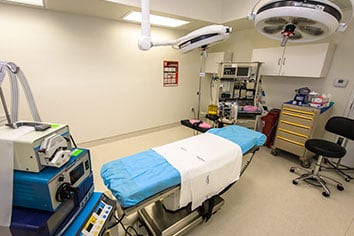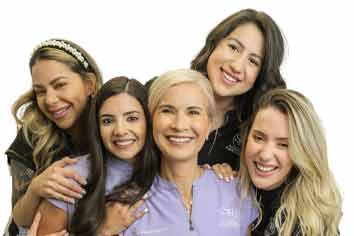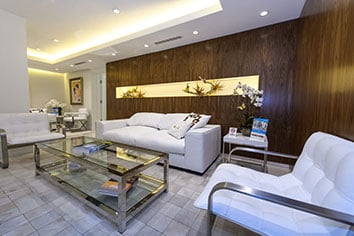Conveniently located to serve the areas of Miami and South Florida

When you think of facial beauty, generally the first things that pop into mind are the eyes, nose, facial volume, and/or skin elasticity. The ears are never really a part of this grouping; however, the smallest difference in earlobe shape can dramatically affect the overall composition and beauty of your face.
Whether congenital in nature, trauma, or heavy or large earrings, earlobe repair surgery with expert surgeon Dr. Silvia Rotemberg can greatly enhance your overall facial beauty.
Contents
What is Earlobe Repair?

Earlobe repair surgery is a procedure that repairs torn, damaged, sagging, or stretched earlobes and returns them to appearing more natural-looking and symmetric.
Since the earlobes are made up solely of cartilage, earlobe damage is pretty easy. Tearing can be caused by earrings or trauma, earlobes can become stretched from gauges, thinning or sagging can occur from aging, and a facelift can cause “pixie ear”. These imperfections are typically very visible, and hair and clothing can only cover so much.
There is no set procedure technique since the extent of earlobe damage differs between patients, so each patient receives a personalized procedure that is tailored to address their specific needs. Although not considered the “sexiest” of all cosmetic procedures, earlobe repair surgery is a commonly requested procedure as earrings are not a dying trend. It requires finesse and a detailed eye for delivering natural-looking results.
Anyone can sew the earlobe or excise a fistula, but it takes a skilled earlobe repair surgeon like Dr. Silvia Rotemberg to understand how minimal yet accurate alterations can achieve great enhancement. Majority of the time patients are able to re-pierce their ears once the earlobes have fully healed.
Reasons to Get Earlobe Repair Surgery
- Torn earlobe: Torn earlobes can be occur from heavy earrings, trauma, or piercing being pulled by children or caught on clothing.
- Stretched/Gauged Earlobe: The earlobe becomes stretched from gauged piercings, and increasingly stretch the larger the gauge size.
- Correction of earlobe after facelift (Pixie ear): After a facelift, the earlobe shape can change and become a dead giveaway that you’ve had a facelift, becoming somewhat attached to the face.
- Droopy, saggy, wrinkly, or thin earlobes: This typically occurs with age as skin loses elasticity and volume.
- Earlobe reduction: Some people’s earlobes may not be sagging, but congenitally large in nature.
Benefits of Earlobe Repair
- Customized procedure for your individual case
- Aesthetically pleasing and proportionate earlobes
- Gauged ears can be normalized
- Ability to re-pierce ears
- Can be performed for all ages
- In-office procedure
- No downtime
- You can immediately return to your daily routine
Ideal Candidates
This procedure is the only option for repairing earlobes.
Ideal candidates for earlobe repair surgery are men and women who are in good health, but whose earlobes have been damaged, torn, stretch, or sag from earrings, a facelift, trauma, age, or congenital in nature. Some may not experience any of the aforementioned conditions, but simply wish to enhance the appearance of their earlobes or have asymmetrical earlobes. Earlobe repair can be performed for patients of any age who wish to repair or change the look of their ears and make them more aesthetically pleasing and normalized.
What to Expect During the Consultation

Dr. Silvia Rotemberg is an industry leader in earlobe repair surgery; she is often sought for her excellent results and bedside manner.
Procedure
Earlobe repair surgery, which is virtually painless, is performed in office under local anesthesia and typically takes less than an hour.
Dr. Silvia Rotemberg performs the procedure under high powered magnification so she can precisely trim the appropriate amount of skin and suture accordingly.
The technique used varies between patients as each injury or tear is different, but it is commonly sutured in a Z-plasty pattern which sutures the inner and outer layers of skin and fatty tissue together. If the piercing hole stretch is too large because of gauges, the connecting portion of the earlobe may be cut and then sutured with this technique as well. Drooping or thin earlobes have the option of surgical or non-surgical repair.
- Torn earlobe: Torn earlobe repair takes about 1 hour with local anesthesia. A layered closure technique can be used, which removes a meticulous amount of skin around the tear and sutures the skin on the back of the earlobe, the subcutaneous tissue in the middle, and the skin on top. Stitches are removed in 7-10 days. You can re-pierce the earlobe 3 months after the procedure.
- Stretched/Gauged earlobe: This is a slightly more complex procedure, depending on the amount of stretch, since Dr. Silvia Rotemberg has to correct the largely stretched out earlobe to return it to its natural shape and contour. The connective piece of skin and tissue is precisely cut, and a portion of the surrounding skin is removed to create a raw edge for rebuilding the earlobe. Either the layered closure or Z-plasty technique is used depending on the specific case. This takes about 1 hour under local anesthesia. Stitches are removed in 7-10 days.
- Correction of earlobe after facelift (Pixie ear): The correction is done under local anesthesia and takes about 1 hour. Dr. Silvia Rotemberg will precisely cut a small notch and suture the “pixie” earlobe to restore a normally hanging earlobe and natural ear shape.
- Droopy, saggy, wrinkly, or thin earlobes: This can be corrected surgically or non-surgically depending on the degree of droopiness and wrinkles. Non-surgical repair is done with injectable fillers (hyaluronic acid: temporary filling lasts about one year) to give back youthful earlobe volume. Surgical technique is done through a small incision in the back of the ear to remove excess skin. Fillers can also be added for added volume. The size and site of the excised skin must be assessed accurately to ensure symmetry and normalcy of the earlobes.
- Earlobe reduction: The appropriate amount of skin and subcutaneous tissue is removed to create the desired size. Stitches will be removed in 7-10 days.
Recovery
Not much postoperative care is needed, but Dr. Silvia Rotemberg will provide you with personalized recovery instructions to aid in your specific case. There is little to no pain after your earlobe repair, and you are able to return to your daily routine immediately. Bandages aren’t typically necessary, and an antibiotic ointment is given to you for postoperative application to prevent infections.
Make sure to keep the suture site clean and dry; this helps speed along the healing process. Some swelling is normal and will subside on its own. Any discomfort can easily be controlled with a cold compress or any over the counter pain medication such as Advil.
 Do not hold a phone or sleep on the side that you had surgery. If you had earlobe repair surgery on both earlobes, please try and sleep on your back and talk on speaker phone if and when possible. You are able to wash your hair, but make sure to do so carefully. Women can wear clip on earrings 2 weeks after their earlobe repair surgery, and can be re-pierced in 3 months.
Do not hold a phone or sleep on the side that you had surgery. If you had earlobe repair surgery on both earlobes, please try and sleep on your back and talk on speaker phone if and when possible. You are able to wash your hair, but make sure to do so carefully. Women can wear clip on earrings 2 weeks after their earlobe repair surgery, and can be re-pierced in 3 months.
It is highly recommended to re-pierce the ear in a different location since the original piercing location is weaker than the surrounding areas. Either to the left or the right of the original placement will suffice. If you a repairing an earlobe without an original piercing or a piercing hole that has closed, please allow 6 month after your procedure to pierce your ear. Heavy earrings are not recommended after re-piercing to maintain a satisfactory result; you want to avoid stretching and pulling the earlobe. Earlobes fully heal in 1 – 2 weeks, and although hardly noticeable already, any surgery scars will fade in 6 – 12 months.
Cost
The cost of your earlobe repair will depend on the extent of your individual case and if it’s performed on one or both earlobes. To receive a quote, please feel free to schedule a private consultation and Dr. Silvia Rotemberg will gladly provide you with one.
















